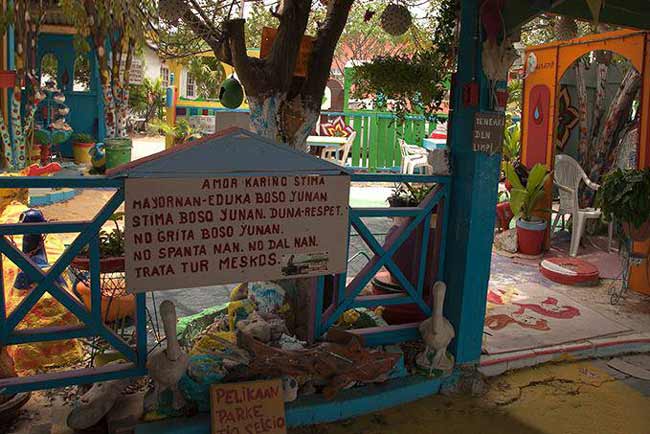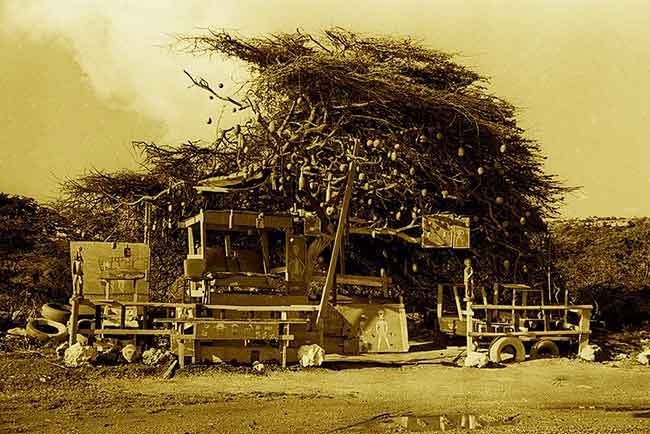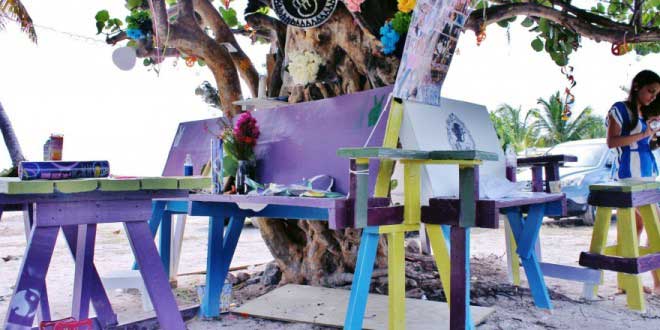Back in the 1960-70s a very unique and distinctive cultural phenomena occurred on Curacao, as a dynamic youth expression of the times! Along the roadways of Curacao, particularly at large tree locations, the youth would build their own hang-out spot, complete with raised high benches, tables for dominoes, music and ornate decorations on the tree. These locations were called by the youth ‘High-Flying Parks’, curiously using an English phrase in the Papiamentu language, as another youth-power expression of those cultural revolution times. Why they used that phrase to name their creations, is for them to know and for us to guess, but likely the sweet aroma often around these parks would give a clue. Seen in the photo is a modern example of a Curacao ‘High-Flying Park’.


High Flying Parks, a Return of Youth Expression
Yet, these locations were far more than just youth hang-out spots, they were true youth-culture expressions of independence, music and freedom, the Curacao version of the global sixties social upheavals and the peace-generation. However, into the 1980s, like the global social movement, the times were changing and the High-Flying Parks were fewer and fewer, often abandoned or removed by the 1990s.

Since 2010, on Curacao’s sister island of St. Maarten, a revitalization of the youth-culture movement has been taking shape, and how did they choose to express themselves? With High-Flying Parks of course, in part for that same sweet smell, but also for the need to have an independent space to be together. A space where they could exchange views, play music and reaffirm a youth identity, as seen in the photo. One of these parks in particular, located at Kim Sha Beach, even has a deeper meaning. It had already become a High-Flying Park, with decorations and benches, where the youth would gather, but then a tragic car accident in 2012 took the life of one of the founding youth organizers of the space, Ms. Noor Ouenniche, the child of a prominent local businessman. After Noor’s death, that large, sea-grape tree at Kim Sha Beach, which is registered on the St. Maarten Historical trees list, became the memorial place for her, and was even supported by her parents with sponsorship of more benches.

There will always be youth, and they will always need a personal youth space to express themselves, free and open. The phenomena of High-Flying Parks was the icon of those youth expressions in the 1960-70s, and now they serve the same purpose on St. Maarten in the early 21st century. These places are in fact heritage sites of the 20th century, and should be recognized as such, yet they also represent the continuity of youth-culture heritage into the 21st century, and thus should be respected as such. Let us restore some of these sites on Curacao, with the youth themselves as the designers and builders, and certainly let us preserve the dignity and rights of our youth on St. Maarten by allowing these sites to thrive. These High-Flying Parks represent One Love for the youth, and their unique cultural tradition continues!

By Dr. Jay B. Haviser
Dr Jay Haviser - SIMARC is the specialist for Monuments and Archaeology at the Ministry of VROMI of the Government of St. Maarten, after having been the Archaeologist for the Netherlands Antilles Government from 1982-2007. He received his doctorate in Archaeology from Leiden University, Netherlands, in 1987, and is currently on the Leiden University Faculty for Archaeology. He was granted Knighthood by Queen Beatrix of the Netherlands in 2008, for his archaeology work in the Netherlands Antilles. Some of his more prominent book publications include: African Sites Archaeology in the Caribbean (1999), and co-editor of African Re-Genesis (2006) - Read more
Pictures: copyright 2013 Ariadne Faies and Being Curacao / nour-o.org
More Customs & Habits articles / Do you wish to write for Colors?



